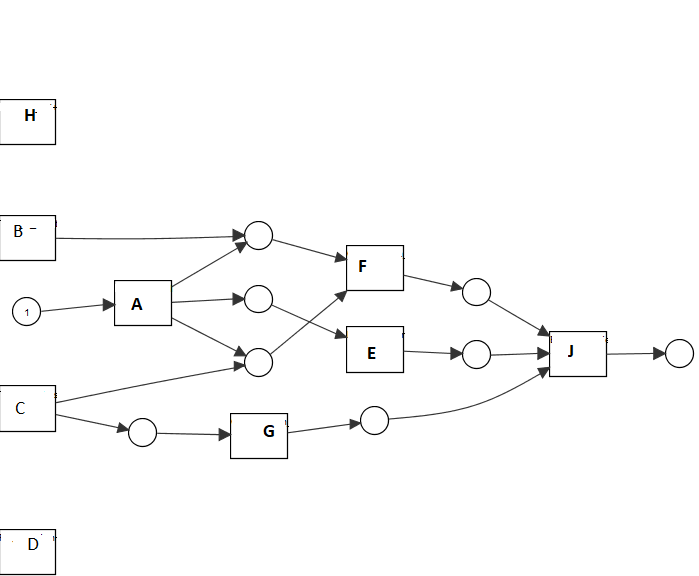To prevent spam users, you can only post on this forum after registration, which is by invitation. If you want to post on the forum, please send me a mail (h DOT m DOT w DOT verbeek AT tue DOT nl) and I'll send you an invitation in return for an account.
Black Transitions in Petri net Model
Hello everyone,
I have an event log and I have been trying to process discovery with this log in ProM 6.9. Firstly I used "Alpha Miner" but the process seems like below even if A placed before D and H placed before J activities in the event log. It did not show the connection between them.

Then I used "Mine Petri net with Inductive Miner" and it generated a more sensible process model below. But, at this time, it generated 3 transition elements which are not placed in event logs. When I look at the .pnml file generated to check the difference, there were 3 transitions that look like the transition below. They not filled with "#FFFFFF" color and their activity properties equal to "$invisible". Also, their name information was kind of "tau join", "tau split", etc.


Also, the BPMN format, which I converted in ProM, of the process above seems like below. In there, I believe that there must be a Parallel Gateway after activity A where I drew. Activity A must be connected to B, D, and E activities on this Gateway.

My questions are;
Burakcan
I have an event log and I have been trying to process discovery with this log in ProM 6.9. Firstly I used "Alpha Miner" but the process seems like below even if A placed before D and H placed before J activities in the event log. It did not show the connection between them.

Then I used "Mine Petri net with Inductive Miner" and it generated a more sensible process model below. But, at this time, it generated 3 transition elements which are not placed in event logs. When I look at the .pnml file generated to check the difference, there were 3 transitions that look like the transition below. They not filled with "#FFFFFF" color and their activity properties equal to "$invisible". Also, their name information was kind of "tau join", "tau split", etc.


Also, the BPMN format, which I converted in ProM, of the process above seems like below. In there, I believe that there must be a Parallel Gateway after activity A where I drew. Activity A must be connected to B, D, and E activities on this Gateway.

My questions are;
- What is the possible reason for the "Alpha Miner" to ignore the connection?
- What are these black transitions and Why do they generate?
- Must any Parallel Gateway be placed as I drew at last BPMN Diagram? It is about the implementation of the conversation algorithm I used or being more than 2 activities after activity A.
Burakcan
Comments
-
Dear Burakcan,
- The Alpha Miner only considers the directly follows relation. If A is never directly followed by D, then A and D will not be connected by a place.
- The black transition are so-called silent(or invisible) transitions. They are not related to any event in the log, but are needed for routing purposes (to model the parallelism between F and G and the fact hat this part can be skipped.
- No, but I do admit that it makes it clearer. By default, an activity in BPMN acts as an exclusive gateway on its inputs and as a parallel gateway on its outputs. As A has multiple outputs, it acts as a parallel gateway on them, and there is no real need to add an explicit parallel gateway. The parallel gateway before J is required, as it would otherwise be an exclusive gateway.
Eric. -
Hi Eric, thanks a lot for your response. I check my event logs right after read your response to check that whether A is directly followed by D. All 3 activities (B, D, and E) follow A directly so I can't figure it out.
On the other hand, I would like to ask something to make it clearer for me. The Parallel Gateway that I asked in question 3 can be added but, at the same time, it can not be added. It is not essential, right?
Best regards,
Burakcan -
Hi Burakcan,Is there also a trace where D is directly followed by A? Otherwise, feel free to send me the log (h.m.w.verbeek@tue.nl), so I can have a look.Yes, indeed, it is not essential. nevertheless, adding it makes it more clear as not everybody knows that implicitly every task is a XOR-join and an AND-split. In a similar way, I would also add a XOR-join before H.Cheers,Eric.
Howdy, Stranger!
Categories
- 1.6K All Categories
- 45 Announcements / News
- 225 Process Mining
- 6 - BPI Challenge 2020
- 9 - BPI Challenge 2019
- 24 - BPI Challenge 2018
- 27 - BPI Challenge 2017
- 8 - BPI Challenge 2016
- 68 Research
- 1K ProM 6
- 395 - Usage
- 290 - Development
- 9 RapidProM
- 1 - Usage
- 7 - Development
- 54 ProM5
- 19 - Usage
- 187 Event Logs
- 32 - ProMimport
- 75 - XESame
